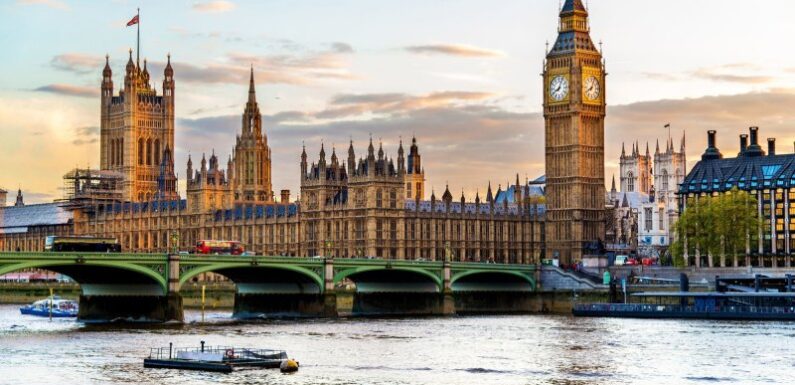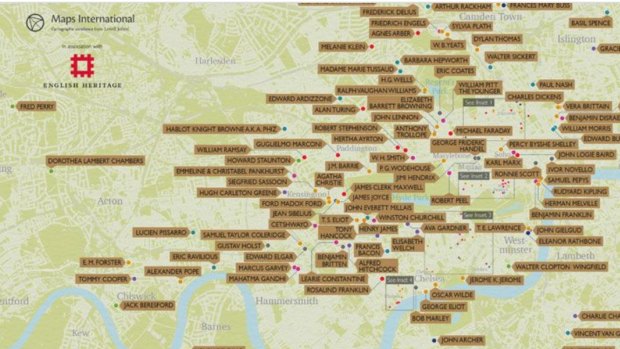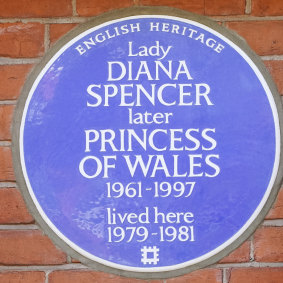
Save articles for later
Add articles to your saved list and come back to them any time.
What in the World, a free weekly newsletter from our foreign correspondents, is sent every Thursday. Below is an excerpt. Sign up to get the whole newsletter delivered to your inbox.
More than a dozen places loaded with local heritage are within a 15-minute walk of my front door here in North London. For a nerd like me, it’s wonderful.
London does an excellent job of celebrating its history and heritage.Credit: Leonid ANDRONOV
My local pub, the Canonbury Tavern, is where George Orwell is said to have drafted some of 1984. Just around the corner, a plaque at 27B Canonbury Square indicates that Orwell lived there from 1944 to 1947.
If I wander off in the other direction, towards my local coffee shop, there’s the house where English author Richard Adams wrote Watership Down, the novel about those scary bunnies.
A bit further west there’s a plaque near Highbury Fields that marks the site of the first gay rights protest in England, in November 1970, against the arrest of Louis Eakes on mere suspicion he was cruising.
According to a blue plaque, George Orwell wrote parts of 1984 at Rob Harris’s local watering hole.Credit: Spectrum Books
If you then stroll south down Upper Street, you’ll find the former home of one of Britain’s great film stars, Gracie Fields. In a restaurant nearby, it’s likely a plaque will one day mark the spot where Tony Blair and Gordon Brown struck a pact that would deliver New Labour and cast the Conservatives from power for the first time in 18 years.
A few years back, keen to encourage people to get out and look for the blue plaques that commemorate the city’s great and good, English Heritage launched a scratchcard map. It’s like those scratchies you can buy from the newsagent, but with more reliable rewards. It shows 220 of the city’s 970-odd plaques and you scrape away the gold coating to reveal the blue panel for each one you find.
A blue plaques scratch map – like a scratchie ticket from the newsagent, only winning is more likely.Credit:
Walk anywhere in London and you’ll stumble across unremarkable places where remarkable people once lived: Agatha Christie, Kwame Nkrumah, Alan Turing, Edith Cavell, Derek Jarman, Mahatma Gandhi, the list goes on.
The English Heritage blue plaque outside Coleherne Court, Old Brompton Road, London.Credit: PA
While in Clapham over the summer, I happened upon a church where William Wilberforce and The Clapham Sect worshipped. Their campaigning resulted in the abolition of slavery in British Dominions.
In St James’s Square you’ll find a blue plaque for Nancy Astor, the first woman to sit in parliament; in Marylebone, the house where the “Liberator of Latin America”, Simón Bolívar, lived in 1810. In Bloomsbury, a blue plaque commemorates the secret agent Noor Inayat Khan, the first female radio operator sent into occupied France during World War II.
There’s quite a duo in Mayfair. Composer George Frideric Handel lived at number 25 Brook Street from 1723 until his death and in 1968 Jimi Hendrix moved in to number 23.
A few weeks ago, my six-year-old daughter came to visit from Australia. Of course, boring dad pointed out a plaque on our way to the park. To my surprise (and pride) she was totally captured by the idea that, as I explained to her, if you do something remarkable in your life you might get a plaque on your home. Next time she visits she wants to go plaque hunting with me. I can’t think of a better way to feed a young curious mind.
For the past 150 years, the blue plaques scheme has been a London-only phenomenon, though it’s obviously not the only place in the UK with incredible history. Last month, however, the government announced it would be extended across England, with communities about to research their own local history and nominate figures who have helped define the towns, villages and cities they call home. The resultant plaques will shine a spotlight on diverse aspects of local heritage across the country.
A report by Heritage England a few years ago found that when more people are aware of their local history it can help boost their connection to and pride in their area, as well as encourage growth in local economies through new visitors coming to explore and learn about the local heritage.
While many Australians lament the lack of history in our cities compared to those in the UK and Europe, it’s important to note that most of England’s blue plaques are from the past 200 years. That’s something Australia’s major capitals, suburbs and regional towns could easily match.
Sydney has made great inroads with its own scheme and hopefully other state governments or councils will follow. There is growing interest in recognising pioneering women and people from minority backgrounds, and plaques are certainly less expensive than statues. Environment Minister Tanya Plibersek would do well to consider funding a national rollout: Vida Goldstein lived here or Pastor Doug Nicholls preached there. Fanny Durack first swam here or Rosemary Balmford was born here.
We have so many great stories to tell. We should hop to it.
Get a note directly from our foreign correspondents on what’s making headlines around the world. Sign up for the weekly What in the World newsletter here.
Most Viewed in World
From our partners
Source: Read Full Article



